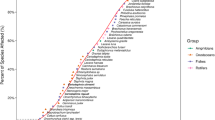Abstract
Amphibian populations are decreasing in size due to environmental stressors in most areas of southern China. Pesticides are known to be a group of potential stressors to amphibians, especially in agricultural ecosystems. Profenofos, an organophosphate insecticide and acaricide, is widely used for controlling insect pests in China. The aim of this study is to evaluate the acute lethality and genotoxicity of profenofos to amphibian under controlled conditions. Results showed that profenofos was highly lethal to tadpoles of Rana spinosa, with 50% lethal concentration (LC50) values of 1.59, 1.14, 0.77, and 0.58 mg l−1 at 24, 48, 72, and 96 h, respectively. DNA damage of erythrocytes was observed by alkaline single-cell gel electrophoresis assay at all tested sublethal concentrations. The study also showed, by micronucleus test, that profenofos at moderate to high sublethal concentration might have genotoxicity to the tadpole after 96 h exposure. Furthermore, based on our results, it is suggested that the alkaline single-cell gel electrophoresis assay could be used as a screening tool for biomonitoring of pesticide contamination in aquatic systems or agricultural ecosystems.


Similar content being viewed by others
References
Alford RA, Dixon PM, Pechmann JH (2001) Global amphibian population declines. Nature 412:499–500
Barni S, Boncompagni E, Grosso A (2007) Evaluation of Rana snk esculenta blood cell response to chemical stressors in the environment during the larval and adult phases. Aquat Toxicol 81:45–54
Blaustein AR, Romansic JM, Kiesecker JM, Hatch AC (2003) Ultraviolet radiation, toxic chemicals and amphibian population declines. Divers Distrib 9:123–140
Campana MA, Panzeri AM, Moreno VJ (2003) Micronuclei induction in Rana catesbeiana tadpoles by the pyrethroid insecticide lambda-cyhalothrin. Genet Mol Biol 26:99–103
Cavas T, Konen S (2007) Detection of cytogenetic and DNA damage in peripheral erythrocytes of goldfish (Carassius auratus) exposed to a glyphosate formulation using the micronucleus test and the comet assay. Mutagenesis 22:263–268
Costa C, Silvari V, Mechini A, Catania S (2009) Genotoxicity of imidacloprid in relation to metabolic activation and composition of the commercial product. Mutat Res Genet Toxicol Environ Mutagen 672:40–44
Das GP, Shaik AP, Jamil K (2006) Cytotoxicity and genotoxicity induced by the pesticide profenofos on cultured human peripheral blood lymphocytes. Drug Chem Toxicol 29:313–322
Fahmy MA, Abdalla EF (1998) Genotoxicity evaluation of buprofezin, petroleum oil and profenofos in somatic and germ cells of male mice. J Appl Toxicol 18:301–305
Farah MA, Bushra A, Niamat AM, Rubina S, Waseem A (2004) Studies on lethal concentrations and toxicity stress of some xenobiotics on aquatic organisms. Chemosphere 55:257–265
Feng SL, Kong ZM, Wang XM, Zhao LR (2004) Acute toxicity and genotoxicity of two novel pesticides on amphibian, Rana N. Hallowell. Chemosphere 56:457–463
Feng SL, Kong ZM, Wang XM, Peng PG (2005) Assessing the genotoxicity of imidacloprid and RH-5849 in human peripheral blood lymphocytes in vitro with comet assay and cytogenetic tests. Ecotox Environ Safe 61:239–246
Gómez F, Martínez-Toledo MV, Salmerón V, Rodelas B (1999) Influence of the insecticides profenofos and diazinon on the microbial activities of Azospirillum brasilense. Chemosphere 39(6):945–957
Gosner KL (1960) A simplified table for staging anuran embryos and larvae with notes on identification. Herpetologica 16:183–190
Houlahan JE, Findlay CS, Schmidt BR, Meyer AH, Kuzmin SL (2000) Quantitative evidence for global amphibian population declines. Nature 404:754–755
Kumar A, Chapman JC (1998) Profenofos toxicity to the eastern rainbow fish (Melanotaenia Duboulayi). Environ Toxicol Chem 17:1799–1806
Kumaravel TS, Vilhar B, Jha AN (2009) Comet assay measurements: a perspective. Cell Biol Toxicol 25:53–64
McDaniel KL, Moser VC (2004) Differential profiles of cholinesterase inhibition and neurobehavioral effects in rats exposed to fenamiphos or profenofos. Neurotoxicol Teratol 26:407–415
Min KJ, Cha CG (2000) Determination of the bioconcentration of phosphamidon and profenofos in zebrafish (Brachydanio rerio). Bull Environ Mol Mutagen 65:611–617
Mouchet F, Gauthier L, Mailhes C, Ferrier V (2006) Comparative evaluation of genotoxicity of captan in amphibian larvae (Xenopus laevis and Pleurodeles waltl) using the comet assay and the micronucleus test. Environ Toxicol 21:264–277
OR AFN (2000) Association française de normalisation, NFT90–325. Qualité de l’eau—evaluation de la génotoxicité au moyen de larves d’amphibiens (Xenopus laevis, Pleurodeles altl). France, AFNOR
Rao JV, Shilpanjali D, Kavitha P (2003) Toxic effects of profenofos on tissue acetylcholinesterase and gill morphology in a euryhaline fish, Oreochromis mossambicus. Arch Toxicol 77:227–232
Reddy NC, Rao JV (2008) Biological response of earthworm, Eisenia foetida (Savigny) to an organophosphorous pesticide, profenofos. Ecotoxicol Environ Safe 71:574–582
Satapornvanit K, Baird DJ, Little DC (2009) Laboratory toxicity test and post-exposure feeding inhibition using the giant freshwater prawn Macrobrachium rosenbergii. Chemosphere 74:1209–1215
Singh NP, McCoy MT, Tice RR, Schneider EL (1988) A simple technique for quantitation of low levels of damage in individual cells. Exp Cell Res 175:184–191
Sparling DW, Matson C, Bickham J (2006) Toxicity of glyphosate as Glypro and LI700 to red-eared slider (Trachemys scripta elegans) embryos and early hatchlings. Environ Toxicol Chem 25:2768–2774
Tao JX, Liu AX, Sun MJ (2004) Research on population quantity of main amphibian in Zhejiang province. J Zhejiang Univ (Agric Life Sci) 30(5):536–540
Tice RR, Agurell E, Anderson D, Burlinson B, Hartmann A (2000) Single cell gel/comet assay: guidelines for in vitro and in vivo genetic toxicology testing. Environ Mol Mutagen 35:206–221
Vuyyuri SB, Ishaq M, Kuppala D, Groverm P, Ahuja YR (2006) Evaluation of micronucleus frequencies and DNA damage in glass workers exposed to arsenic. Environ Mol Mutagen 47:562–570
Yin XH, Li SN, Zhang L (2008) Evaluation of DNA damage in Chinese toad (Bufo bufo gargarizans) after in vivo exposure to sublethal concentrations of four herbicides using the comet assay. Ecotoxicology 17:280–286
Acknowledgments
We thank Dr. Wenjun Gui and Dr. Yihua Liu for critical revisions. We are also grateful to Yirong Guo, Dr. Chizhou Liang, and Professor Puii Sailo for their very kind help in improving the English.
Author information
Authors and Affiliations
Corresponding author
Rights and permissions
About this article
Cite this article
Li, X., Li, S., Liu, S. et al. Lethal Effect and In Vivo Genotoxicity of Profenofos to Chinese Native Amphibian (Rana spinosa) Tadpoles. Arch Environ Contam Toxicol 59, 478–483 (2010). https://doi.org/10.1007/s00244-010-9495-4
Received:
Accepted:
Published:
Issue Date:
DOI: https://doi.org/10.1007/s00244-010-9495-4




